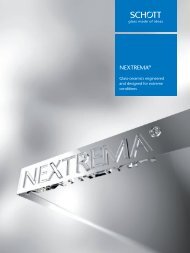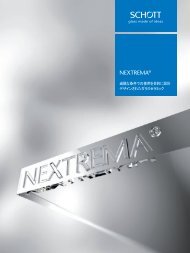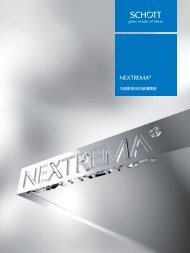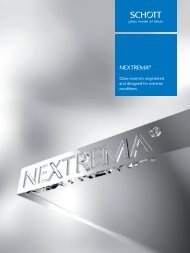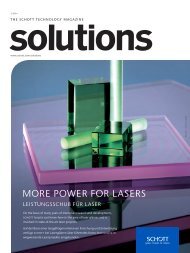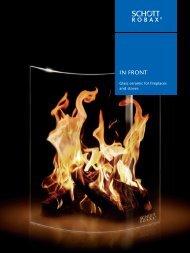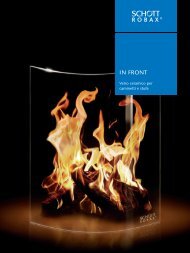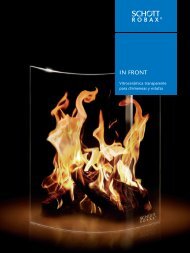SCHOTT Technical Glasses
Apart from its application in optics, glass as a technical material has exerted a formative influence on the development of important technological fields such as chemistry, pharmaceutics, automotive, optics, optoelectronics and information technology. SCHOTT Technical Glasses offers pertinent information in concise form. It contains general information for the determination and evaluation of important glass properties and also informs about specific chemical and physical characteristics and possible applications of the commercial technical glasses produced by SCHOTT. With this brochure, we hope to assist scientists, engineers, and designers in making the appropriate choice and make optimum use of SCHOTT products.
Apart from its application in optics, glass as a technical material has exerted a formative influence on the development of important technological fields such as chemistry, pharmaceutics, automotive, optics, optoelectronics and information technology. SCHOTT Technical Glasses offers pertinent information in concise form. It contains general information for the determination and evaluation of important glass properties and also informs about specific chemical and physical characteristics and possible applications of the commercial technical glasses produced by SCHOTT. With this brochure, we hope to assist scientists, engineers, and designers in making the appropriate choice and make optimum use of SCHOTT products.
You also want an ePaper? Increase the reach of your titles
YUMPU automatically turns print PDFs into web optimized ePapers that Google loves.
54<br />
Because fillers reduce the flow capability during the soldering<br />
process, they can be added to the batch only in limited<br />
amounts.<br />
Taking into consideration the properties of the materials to<br />
be joined, suitable solder glasses are mainly selected under<br />
the following aspects:<br />
1. highest permissible soldering temperature,<br />
2. thermal expansion of the materials to be joined,<br />
3. maximum application temperature of the solder zone,<br />
4. chemical behavior.<br />
Processing<br />
To achieve satisfactory soldering, the solder glass must flow<br />
sufficiently and wet the parts to be joined well. Flow and<br />
wetting are temperature- and time-controlled; the higher<br />
the temperature, the less time is required for sufficient flow,<br />
and vice versa.<br />
Thus, soldering at high temperatures may take only a few<br />
minutes, whereas at low temperatures (i.e. at viscosities<br />
≥ 10 7 dPa · s) reaching sufficient flow takes very long and<br />
usually can be achieved only under additional mechanical<br />
load.<br />
Properties<br />
As with all sealings involving glass, adapting the thermal expansions<br />
of the components to be joined with solder glass<br />
α (20/300)<br />
––><br />
12<br />
10<br />
8<br />
6<br />
4<br />
Composite<br />
Vitreous solder glass<br />
Devitrifying<br />
solder glass<br />
2<br />
400 450 500 550 600 650 700<br />
Soldering temperature in °C ––><br />
Fig. 44. Relationship between soldering temperature and linear<br />
expansion α for solder glasses. The curves describe the lowest limits<br />
for the respective solder glass types.<br />
Spherical lense (center) sealed to a metal casing with a sintered solder<br />
glass ring<br />
is a necessary prerequisite for stable, gas-/leak-tight joins.<br />
As a rule, the coefficient of thermal expansion of the solder<br />
glasses should be by Δα = 0.5 – 1.0 x 10 –6 /K smaller than the<br />
expansion coefficients of the sealing partners.<br />
The relationship between soldering temperature and thermal<br />
expansion is schematically shown in Figure 44.<br />
With devitrifying solder glasses, one must consider that the<br />
expansion coefficients given in the respective lists of properties<br />
are only valid on condition that the specific soldering<br />
program defined for each solder glass is complied with.<br />
Changing the soldering program, in particular the soldering<br />
temperature and the soldering time, may affect the relationship<br />
between glassy and crystalline phase and thus change<br />
the coefficient of thermal expansion, with the possible result<br />
of a mismatch.<br />
Sealing joints produced with vitreous solder glasses can be<br />
loaded to approximately 50 K below the transformation<br />
temperature of the respective solder glass. The maximum<br />
service temperature of devitrifying solder glasses depends<br />
on the type and melting point of the precipitated crystals<br />
and on the amount and properties of the residual glass<br />
phase. Up to maximum service temperature, solder glasses<br />
are moisture- and gas-proof. Their good electric insulating<br />
property is superior to that of many standard technical<br />
glasses. They are therefore also suitable as temperatureresistant<br />
insulators. The chemical resistance of solder glasses<br />
is generally lower than that of standard technical glasses.<br />
Therefore, solder glass sealings can be exposed to chemically






